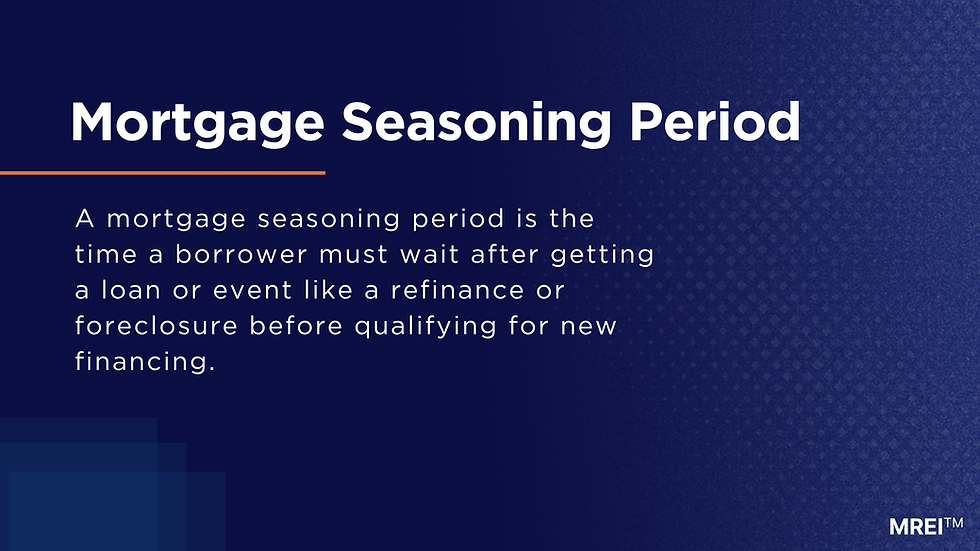Mortgage Seasoning Period: Meaning, Limitations, Example
- Lukas Müller, PhD

- Jul 6, 2025
- 3 min read

A mortgage seasoning period refers to the length of time a borrower must wait after taking out a mortgage or completing a financial event like a foreclosure or refinance before becoming eligible for a new mortgage or financial action. In real estate, “seasoning” essentially means establishing a track record. Lenders use seasoning periods to assess how long you've owned a property, made consistent payments, or held a loan before allowing actions like refinancing, cash-out loans, or using the property in certain transactions.
Depending on the lender and the purpose, seasoning periods can range from a few months to several years. They're especially important in underwriting decisions and play a key role in both conventional and non-conventional financing.
How Mortgage Seasoning Works
The most common use of seasoning periods is in refinancing. For example, many lenders require at least six months of on-time mortgage payments before you can refinance your loan. Similarly, for a cash-out refinance, you may need to wait six to twelve months after purchasing the home, and the loan-to-value ratio may be calculated using the original purchase price rather than current market value if too little time has passed.
Seasoning also applies after major credit events. If you've had a bankruptcy, short sale, or foreclosure, most lenders impose a waiting period—often two to seven years—before you’re eligible for a new mortgage. And for investors, some lenders want a property to be seasoned for a specific time before it can be used in a portfolio loan or as leverage for another acquisition.
Limitations and Risks of Seasoning Periods
While seasoning periods are meant to protect lenders from rapid or speculative transactions, they can frustrate borrowers—especially those who improve a property quickly and want to refinance or sell. For example, someone who buys a home, renovates it within three months, and tries to refinance based on the improved value may be told to wait until the six-month mark to qualify for full appraised value.
Another limitation is the lack of standardization. Different lenders, loan types, and jurisdictions apply seasoning requirements differently. What’s acceptable for a conventional loan might not work for FHA, VA, or portfolio lending. This inconsistency can cause confusion or delays in funding, especially for inexperienced borrowers or first-time investors.
Real-World Example
An investor purchases a distressed property for £200,000, renovates it over three months, and now has an appraisal showing it's worth £280,000. They apply for a cash-out refinance based on the new value, but the lender denies it, stating that the property hasn’t met the six-month seasoning requirement. The investor must either wait until the seasoning period ends or take a smaller loan based on the original purchase price—delaying their next deal or reducing available capital.
Why It Matters in Real Estate Financing
Seasoning periods affect both timing and strategy in real estate finance. For homeowners, it determines when they can access better rates or unlock equity. For investors, it can make or break a project timeline—especially in fix-and-flip or BRRRR strategies. Understanding the rules around mortgage seasoning helps prevent delays, surprises, or wasted money during refinancing, selling, or leveraging.
It’s also important when working with non-traditional lenders. Some private lenders may not require any seasoning at all, while others will enforce strict policies to avoid funding speculative deals or overleveraged properties.
Final Thoughts
Mortgage seasoning periods may sound like an industry technicality, but they can have major impacts on what you can do—and when. Whether you're refinancing, flipping, or buying again after a financial setback, knowing the seasoning rules ahead of time gives you an edge. Plan around them, ask your lender early, and always check how seasoning could affect your timeline and financing goals.








